

|
| FRANCE | FRANCE |
| région: Île de France | |
| département: 75, Paris |
How should one describe Paris? The Prussian State Minister Wilhelm von Humboldt wrote to the poet Friedrich Schiller in 1799: „Ich habe in der Tat nie einen Punkt gesehen, der soviel Größe, Pracht und Schönheit auf einmal in sich vereinigt“ („Indeed I have never seen a place that in itself united so much grandeur, splendour and beauty“).
The origins of the city go back to the 3rd century BC when the Parisii founded the first settlement on the Île de la Cité in the river Seine. The Roman town that began to develop after the battle at Grenelle (today in the 15th arrondissement) of 52 BC, which was described by Julius Caesar in his Bello Gallico, became known as Lutetia Parisiorum during the 1st century AD. In the early 3rd century the town already had 20,000 inhabitant, but was destroyed in 280 during the Migrations Period. The name Paris appears first in 360. In 508 Chlodwig made Paris the capital of the Merowingian empire. From the 14th until the 16th century, the kings of France did not reside in Paris but in the Loire region. It was the King Henri IV (crowned 1589) who returned to Paris after having converted to the Catholic faith in 1572. The French Revolution started in Paris on 14th July 1789, and saw the decapitation of King Louis XVI and Queen Marie-Antoinette in 1793. Napoleon I founded the First Empire in 1804, which ended ten years later with the restauration of the kingdom under Louis XVIII. The Second Republic (1848–1852) and the Second Empire under Napoléon III (1852–1870) were succeeded by the Third Republic (1871–1940), which was ended by the Pétain regime (1940–1944). After a provisional government (1944–1947) the Fourth Republic was proclaimed in 1947. The constitution of the present, Fifth Republic was passed in 1958, its first president was general Charles de Gaulle. France was one of the founders of the European Union: the Treaty Establishing the European Coal and Steel Community, the first of the four founding treaties of the EU, was signed in Paris on 18th April 1951; it was followed by the Treaty Establishing the European Atomic Energy Community (Euratom) and the Treaty Establishing the European Economical Community (EEC), both signed on 25th of March 1957 in Rome, and the final Treaty on European Union, signed on the 7th of February 1993 in Maastricht.
Paris was selected by the Council of the European Union to be European City of Culture for 1989. The banks of the river Seine, the historic centre of Paris, were listed as a UNESCO World Heritage site in 1991.

The Arc du Triomphe du Carrousel [left, no. 4922] was built between
1806 and 1808 to commemorate Napoleon's military victories in the Wars of the Third and Fourth Coalitions (1805–1806, 1806–1807).
Designed by Charles Percier and Pierre François Léonard Fontaine, the arch was built on the model of the Arch of Constantine in
Rome, as a gateway of the Tuileries Palace, the Imperial residence. The destruction of the Tuileries Palace during the
Paris Commune in 1871, allowed an unobstructed view west towards the Arc de Triomphe.
It is an example of Neoclassical architecture in the Corinthian order. The monument is 19 metres high, 23 metres wide, and 7.3 metres
deep. The 6.4 metre high central arch is flanked by two smaller ones, 4.3 metres high and 2.7 metres wide. Around its exterior are
eight Corinthian columns of marble. These columns were recovered from the Château de Meudon, destroyed in 1804. Napoleon's diplomatic and
military victories are commemorated by bas-reliefs executed in rose marble. They depict: the Peace of Pressburg (Bratislava),
Napoleon entering Munich, Napoleon entering Vienna, the Battle of Austerlitz
(Slavkov u Brna), the Tilsit (Советск / Sovetsk) Conference,
and the surrender of Ulm.
[Text adapted from https://en.wikipedia.org/wiki/Arc_de_Triomphe_du_Carrousel]
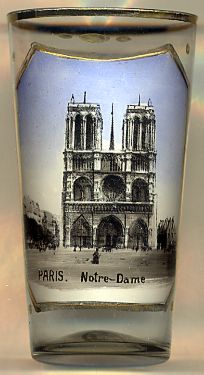

 Notre-Dame de Paris is located on the eastern half of the Île de la Cité. It is the cathedral of the Catholic archdiocese of Paris.
Notre Dame de Paris was one of the first Gothic cathedrals, and its construction spanned the Gothic period.
Notre Dame de Paris is widely considered one of the finest examples of French Gothic architecture in the world.
Notre-Dame de Paris is located on the eastern half of the Île de la Cité. It is the cathedral of the Catholic archdiocese of Paris.
Notre Dame de Paris was one of the first Gothic cathedrals, and its construction spanned the Gothic period.
Notre Dame de Paris is widely considered one of the finest examples of French Gothic architecture in the world.
Construction began in 1163, during the reign of Louis VII, and opinion differs as to whether Maurice de Sully or Pope Alexander III laid the foundation stone of the cathedral. However, both were at the ceremony in question. Bishop de Sully went on to devote most of his life and wealth to the cathedral's construction. Construction of the west front, with its distinctive two towers, began about the year 1200, before the nave had been completed, contrary to normal construction practice. Over the construction period, numerous architects worked on the site, as is evidenced by the differing styles at different heights of the west front and towers. Between 1210 and 1220, the fourth architect oversaw the construction of the level with the rose window and the great halls beneath the towers. The towers were completed around 1245, and the cathedral was completed around 1345.
In 1548, rioting Huguenots damaged features of the cathedral, considering them idolatrous. During the reigns of Louis XIV and Louis XV, the cathedral underwent major
alterations as part of an ongoing attempt to modernize cathedrals throughout Europe. Tombs and stained glass windows were destroyed. The north and south rose windows
were spared this fate, however. In 1793, during the French Revolution, the cathedral was rededicated to the Cult of Reason, and then to the Cult of the Supreme Being.
During this time, many of the treasures of the cathedral were either destroyed or plundered. The statues of biblical kings of Judah (erroneously thought to be kings of
France) were beheaded. Many of the heads were found during a 1977 excavation nearby and are on display at the Musée de Cluny. For a time, Lady Liberty replaced the
Virgin Mary on several altars. The cathedral's great bells managed to avoid being melted down. The cathedral also came to be used as a warehouse for the storage of food.
A restoration program was initiated in 1845, overseen by architects Jean-Baptiste-Antoine Lassus and Eugène Viollet-le-Duc. The restoration lasted 25 years and included
the construction of a flèche (a type of spire) as well as the addition of the chimeras on the Galerie des Chimères.
In 1871, during the period of the Paris Commune, the cathedral was nearly set alight: some records suggest that the rebels even went so far as to set fire to a mound of
chairs within the building. Whether that was so or not, the cathedral survived the Commune period essentially unscathed.
In 1939, during World War II, it was feared that German bombers could destroy the windows; as a result, on September 11, 1939, they were removed and then
restored at the end of the war. Artwork, relics, and other antiques stored at the cathedral include the supposed Crown of
Thorns which Jesus wore prior to his crucifixion and a piece of the cross on which he was crucified. While undergoing
renovation and restoration, the roof of Notre-Dame caught fire on the evening of 15 April 2019. Burning for around
15 hours, the cathedral sustained serious damage, including the destruction of the flèche (the timber spire over
the crossing) and most of the lead-covered wooden roof above the stone vaulted ceiling. The restauration was completed in 2024.
[Text adapted from http://en.wikipedia.org/wiki/Notre-Dame_de_Paris]
Other places which claim one of the many reliquiaries of particles of the Holy Crucifix and of which there
are glasses in this collection are the
Cistercian abbeys of Heiligenkreuz and Lilienfeld (Austria),
the former monastery Heilig Kreuz in Donauwörth and the cathedral of
Limburg a. d. Lahn (Germany).
|
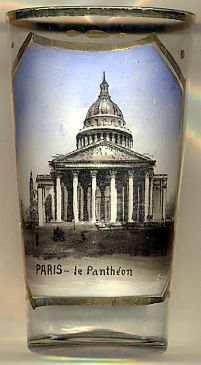
The  Panthéon was originally built as a church dedicated to Ste. Geneviève, but after many changes now combines liturgical functions
with its role as a famous burial place. It is an early example of Neoclassicism, with a façade modelled on the Pantheon in Rome, surmounted
by a small dome that owes some of its character to Bramante's "Tempietto". Located on the Montagne Sainte-Geneviève, the Panthéon looks out over all of Paris.
Its architect, Jacques-Germain Soufflot, had the intention of combining the lightness and brightness of the gothic cathedral with classical principles. Soufflot died
before his work was achieved, and his plans were not entirely followed. The transparency he had planned for his masterpiece was not attained. Nevertheless, it is one
of the most important architectural achievements of its time and the first great neoclassical monument.
Panthéon was originally built as a church dedicated to Ste. Geneviève, but after many changes now combines liturgical functions
with its role as a famous burial place. It is an early example of Neoclassicism, with a façade modelled on the Pantheon in Rome, surmounted
by a small dome that owes some of its character to Bramante's "Tempietto". Located on the Montagne Sainte-Geneviève, the Panthéon looks out over all of Paris.
Its architect, Jacques-Germain Soufflot, had the intention of combining the lightness and brightness of the gothic cathedral with classical principles. Soufflot died
before his work was achieved, and his plans were not entirely followed. The transparency he had planned for his masterpiece was not attained. Nevertheless, it is one
of the most important architectural achievements of its time and the first great neoclassical monument.
King Louis XV vowed in 1744 that if he recovered from an illness he would replace the ruined church of Sainte-Geneviève with an edifice worthy of the patron saint of Paris. Soufflot was chosen for the construction of the new Église Sainte-Geneviève, a major work in the neoclassical style. The overall design was that of a Greek cross with massive portico of Corinthian columns. Its ambitious lines called for a vast building 110 meters long by 84 meters wide, and 83 meters high. No less vast was its crypt. The foundations were laid in 1758, but due to financial difficulties, it was only completed after Soufflot's death, by his pupil Jean-Baptiste Rondelet, in 1789. As it was completed at the start of the French Revolution, the new Revolutionary government ordered it to be changed from a church to a mausoleum for the interment of great Frenchmen. Twice since then it has reverted to being a church, only to become again a temple to the great intellectuals of France.
Among those buried in its necropolis are Voltaire, Rousseau, Victor Hugo, Émile Zola, Jean Moulin, Marie Skłodowska-Curie, Pierre Curie, Louis Braille, Jean Jaurès,
Alexandre Dumas (père) and Soufflot,
its architect. A widely-repeated story that the remains of Voltaire were stolen by religious fanatics in 1814 and thrown into a garbage heap is false. Such rumours resulted
in the coffin being opened in 1897, which confirmed that his remains were still present.
[Text adapted from http://en.wikipedia.org/wiki/Panthéon_(Paris)]

The  Tour Eiffel [left, no. 4921] on the Champ de Mars is named after the
engineer Gustave Eiffel, whose company designed and built the tower from 1887 to 1889.
Locally nicknamed La dame de fer ('the Iron Lady'), it was constructed as the centrepiece of the 1889 World's Fair,
and to crown the centennial anniversary of the French Revolution. Although initially criticised by some of France's leading artists
and intellectuals for its design, it has since become a global cultural icon of France and one of the most recognisable structures
in the world. It was designated a monument historique in 1964, and was named part of a UNESCO World Heritage Site ("Paris, Banks of
the Seine") in 1991. The tower is 330 metres tall and the tallest structure in Paris. Its base is square, measuring 125 metres on
each side. During its construction, the Eiffel Tower surpassed the Washington Monument in Washington, DC,
to become by far the tallest human-made structure in the world, a title it held for 41 years until the Chrysler Building in
New York City was finished in 1930. It was the first structure in the world to surpass both the 200 metres
and 300 metres mark in height. Due to the addition of a broadcasting aerial at the top of the tower in 1957, it is now taller
than the Chrysler Building by 5.2 metres. Excluding transmitters, the Eiffel Tower is the second tallest free-standing structure in
France after the Millau Viaduct.
Tour Eiffel [left, no. 4921] on the Champ de Mars is named after the
engineer Gustave Eiffel, whose company designed and built the tower from 1887 to 1889.
Locally nicknamed La dame de fer ('the Iron Lady'), it was constructed as the centrepiece of the 1889 World's Fair,
and to crown the centennial anniversary of the French Revolution. Although initially criticised by some of France's leading artists
and intellectuals for its design, it has since become a global cultural icon of France and one of the most recognisable structures
in the world. It was designated a monument historique in 1964, and was named part of a UNESCO World Heritage Site ("Paris, Banks of
the Seine") in 1991. The tower is 330 metres tall and the tallest structure in Paris. Its base is square, measuring 125 metres on
each side. During its construction, the Eiffel Tower surpassed the Washington Monument in Washington, DC,
to become by far the tallest human-made structure in the world, a title it held for 41 years until the Chrysler Building in
New York City was finished in 1930. It was the first structure in the world to surpass both the 200 metres
and 300 metres mark in height. Due to the addition of a broadcasting aerial at the top of the tower in 1957, it is now taller
than the Chrysler Building by 5.2 metres. Excluding transmitters, the Eiffel Tower is the second tallest free-standing structure in
France after the Millau Viaduct.
[https://en.wikipedia.org/wiki/Eiffel_Tower]
The
Both constructions were removed after the end of the exhibition.
(See also the Grand Palais and Petit Palais below.)
The
In the attic above the richly sculptured frieze of soldiers are 30 shields engraved with the names of major Revolutionary and Napoleonic military victories:
Valmy, Jemmapes, Fleurus, Montenotte, Lodi, Castiglione, Arcole, Rivoli, Les Pyramides, Aboukir, Alkmaer, Zurich (Zurich),
Heliopolis, Marengo, Hohenlinden, Ulm, Austerlizt (Slavkov u Brna), Iéna (Iéna),
Friedland (today Правдинск/Prawdinsk), Sierra, Essling (today part of Vienna),
Wagram, Moscowa, Lutzen, Bleutzen, Dresde (Dresden), Hanau, Montmirail, Montereau, Lagny.
The inside walls of the monument list the names of 558 French generals; the names of those who died in battle are underlined. Also inscribed, on the shorter sides
of the four supporting columns, are the names of the major battles of the Napoleonic Wars:
Lille, Hondschootte, Wattignies, Arlon, Courtrai, Tourcoing, Weissembourg (Wissembourg),
Maestricht, Aldenhoven, Landau, Neuwied, Rastadt (Rastatt), Etlingen (Ettlingen),
Neresheim, Bamberg, Amberg, Friedberg,
Biberach, Altenkirchen, Schliengen, Kehl, Engen, Moeskirch, Hochstett, Wertingen,
Guntzbourg (Günzburg), Elchingen, Dierstein, Hollabrunn,
Saalfeld,
Halle, Prentzlow, Lubeck (Lübeck), Pultusk,
Eylau (Багратионовск / Bagrationovsk), Ostrolenska,
Dantzig (Gdansk), Heilsberg, Landshut, Eckmulh, Ratisbonne (Regensburg),
Raab (Győr), Mohilew, Smolensko, Valontina, Polotsk, Krasnoe, Wurschen, Loano, Millesimo, Dego, Mondovi, Roveredo, Bassano, St. Georges,
Mantoue, Tagliamento, Sediman, Mont Thabor, Chebreisse, Bassignano, San Giuliano, Dietikon, Mutta Thal, Gênes,
Le Var, Montebello, Le Mincio, Caldiero, Castel Franco, Raguse (Dubrovnik), Gaète,
Le Bastan, Le Boulou, Burgos, Espinosa, Tudela, Ucléz, La Corogne (A Coruña),
Sarragosse, Valls, Medellín, Maria-Belchite,
Almonacid, Ocana, Alba de Tormes, Vique, Lerida, Gudad-Rodrigo,
Almeida, Tortose, Gebora, Badajoz, Tarragone, Sagonte, Valence (València).
Further 32 battles are also named on the interior sides of the small pillars:
Diersheim, Dusseldorf (Düsseldorf), Grand-Port, Mjaroslawietz, Ypres, Luxembourg,
Breslaw (Wrocław), Berg-op-Zoom, Jaffa, Peschiera, Caire, Caprée, Gratz (Graz),
C. de Sprimont, Geisberg, Champaubert, Adige, Montagne Noir, Pozzolo, La Piave, Naples (Napoli), Plaisance, Madrid, Mequinenza,
Roses, Astorga, Girone, Olivenza, Toulouse, M. de Rioseco, Oporto (Porto), Fuente d'Ouoro.
The battles which took place in the period between the departure of
Napoleon from Elba and his final defeat at Waterloo are not included.
Famous victory marches past the Arc included the Germans in 1871, the French in 1918, the Germans in 1940, and the French and Allies in 1944 and 1945.
Charles de Gaulle survived an attack upon him at the Arc during a parade. Beneath the Arc is the Tomb of the Unknown Soldier from the First World War.
Interred here on Armistice Day 1920, it has the first eternal flame lit in Western and Eastern Europe since the Vestal Virgins' fire in the Forum Romanum in
Rome was extinguished in the year 391. It burns in memory of the dead who were never identified (now in both World Wars).
The
The
(See also the Palais de l'Électricité above.)
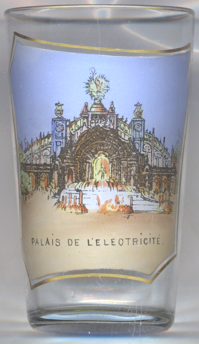
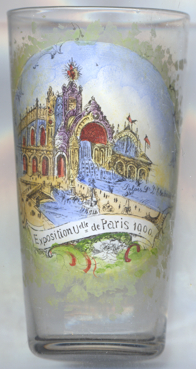
The  Palais de l'Électricité [background] was built by
architect Eugène Hénard for the 1900 World Fair in Paris. The Palace of Electricity moderated all the
energy flowing from one exhibit to the other, and each exhibit was dependent on the palace in order to run.
The Palace of Electricity itself was fitted with five thousand multi-coloured incandescent lamps and eight monumental
lamps on its massive one hundred and thirty meter breadth and seventy meter height.
Palais de l'Électricité [background] was built by
architect Eugène Hénard for the 1900 World Fair in Paris. The Palace of Electricity moderated all the
energy flowing from one exhibit to the other, and each exhibit was dependent on the palace in order to run.
The Palace of Electricity itself was fitted with five thousand multi-coloured incandescent lamps and eight monumental
lamps on its massive one hundred and thirty meter breadth and seventy meter height.
 Château d'Eau [foreground], an ornately decorated monumental
water foundtain directly in front of the Palace of Electricity and actually being part of it was built by Edmond Paulin.
Château d'Eau [foreground], an ornately decorated monumental
water foundtain directly in front of the Palace of Electricity and actually being part of it was built by Edmond Paulin.
(XVIe arrondissement, Passy)
(XVIIe arrondissement, Batignolles-Monceau)
 Arc de Triomphe [left] (arc de triomphe de l'Étoile)
stands in the centre of the Place Charles de Gaulle (until 1970 named Place de l'Étoile) which marks the western end of the Champs-Élysées.
The arch honours those who fought for France, particularly during the Napoleonic Wars.
Designed by Jean Chalgrin in 1806 in the Neoclassical version of ancient Roman architecture, the monument stands 49.5 metres (165 ft) in height,
45 metres (148 ft) wide and 22 meters (72 ft) deep. The monument was inaugurated in 1836 by King Louis Philippe I and is the largest triumphal arch in existence.
Major academic sculptors of France are represented in the sculpture of the Arc de Triomphe: Jean-Pierre Cortot, François Rude, Antoine Étex,
Arc de Triomphe [left] (arc de triomphe de l'Étoile)
stands in the centre of the Place Charles de Gaulle (until 1970 named Place de l'Étoile) which marks the western end of the Champs-Élysées.
The arch honours those who fought for France, particularly during the Napoleonic Wars.
Designed by Jean Chalgrin in 1806 in the Neoclassical version of ancient Roman architecture, the monument stands 49.5 metres (165 ft) in height,
45 metres (148 ft) wide and 22 meters (72 ft) deep. The monument was inaugurated in 1836 by King Louis Philippe I and is the largest triumphal arch in existence.
Major academic sculptors of France are represented in the sculpture of the Arc de Triomphe: Jean-Pierre Cortot, François Rude, Antoine Étex,
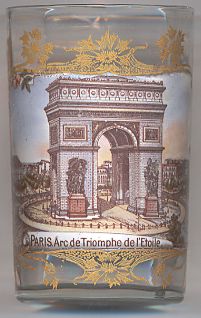 Jean-Jacques Pradier and Philippe Joseph Henri Lemaire. The four sculptural groups at the base of the Arc are Le Triomphe de 1810 (Jean-Pierre Cortot),
La Résistance de 1814 and La Paix de 1815 (both by Antoine Étex) and the most renowned of them all, Le Départ de 1792 commonly called La Marseillaise (François Rude).
Jean-Jacques Pradier and Philippe Joseph Henri Lemaire. The four sculptural groups at the base of the Arc are Le Triomphe de 1810 (Jean-Pierre Cortot),
La Résistance de 1814 and La Paix de 1815 (both by Antoine Étex) and the most renowned of them all, Le Départ de 1792 commonly called La Marseillaise (François Rude).
[Text adapted from http://en.wikipedia.org/wiki/Arc_de_Triomphe]
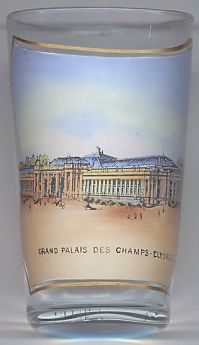
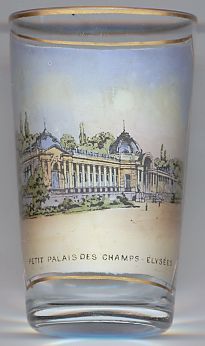
 Grand Palais [left], a large glass exhibition hall, was built for the
Paris World Fair of 1900.
Built at the same time as the Petit Palais and the Pont Alexandre III, the exterior of this massive palace combines an imposing Classical sont façade
with rich Art Nouveau ironwork. The building was closed for 12 years for extensive restoration work after one of the glass ceiling panels fell in 1993.
After restoration, the Grand Palais reopened in 2005.
Grand Palais [left], a large glass exhibition hall, was built for the
Paris World Fair of 1900.
Built at the same time as the Petit Palais and the Pont Alexandre III, the exterior of this massive palace combines an imposing Classical sont façade
with rich Art Nouveau ironwork. The building was closed for 12 years for extensive restoration work after one of the glass ceiling panels fell in 1993.
After restoration, the Grand Palais reopened in 2005.
 Petit Palais [right] was built at the same time as the Grand Palais.
It now houses the Musée des Beaux-Arts de la Ville de Paris.
Petit Palais [right] was built at the same time as the Grand Palais.
It now houses the Musée des Beaux-Arts de la Ville de Paris.

The  Opéra Garnier [left, no. 4920], also known as
Palais Garnier, was built for the Paris Opera from 1861 to 1875 at the behest of Emperor
Napoléon III. Initially referred to as le nouvel Opéra de Paris (the new Paris
Opera), it soon became known as the Palais Garnier, in acknowledgment of its extraordinary opulence and
the architect Charles Garnier's plans and designs, which are representative of the Napoleon III style. It
was the primary theatre of the Paris Opera and its associated Paris Opera Ballet until 1989, when a new opera
house, the Opéra Bastille, opened at the Place de la Bastille. The theatre has been a monument historique
of France since 1923.
Opéra Garnier [left, no. 4920], also known as
Palais Garnier, was built for the Paris Opera from 1861 to 1875 at the behest of Emperor
Napoléon III. Initially referred to as le nouvel Opéra de Paris (the new Paris
Opera), it soon became known as the Palais Garnier, in acknowledgment of its extraordinary opulence and
the architect Charles Garnier's plans and designs, which are representative of the Napoleon III style. It
was the primary theatre of the Paris Opera and its associated Paris Opera Ballet until 1989, when a new opera
house, the Opéra Bastille, opened at the Place de la Bastille. The theatre has been a monument historique
of France since 1923.
[https://en.wikipedia.org/wiki/Palais_Garnier]
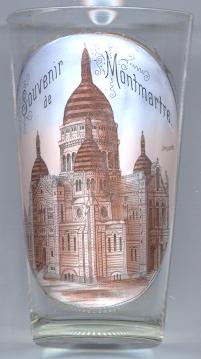
The  Basilique du Sacré-Cœur de Montmartre [left] was initiated
after the defeat of France during the French-German War of 1870/1871. At first the fund-raising was by public subscription
only, but in 1873 the National Assembly declared it a state undertaking. The site chosen for the construction is the butte
Montmartre, by tradition the place of martyrdom of St. Denis, the first bishop of Paris. Seventy-eight entries were
submitted in a competition. Out of these, the plans of Paul Abadie were chosen. The construction was begun in 1875. After
the death of Abadier in 1884 six further architects were involved in the building works. The church was completed in 1914,
but due to the outbreak of World War I it was consecrated only in 1919. In the same year it received the papal title
Basilica minor.
Basilique du Sacré-Cœur de Montmartre [left] was initiated
after the defeat of France during the French-German War of 1870/1871. At first the fund-raising was by public subscription
only, but in 1873 the National Assembly declared it a state undertaking. The site chosen for the construction is the butte
Montmartre, by tradition the place of martyrdom of St. Denis, the first bishop of Paris. Seventy-eight entries were
submitted in a competition. Out of these, the plans of Paul Abadie were chosen. The construction was begun in 1875. After
the death of Abadier in 1884 six further architects were involved in the building works. The church was completed in 1914,
but due to the outbreak of World War I it was consecrated only in 1919. In the same year it received the papal title
Basilica minor.
(see also list of other basilicae minores depicted on glasses of this collection)
![[scale]](lineal.jpg)